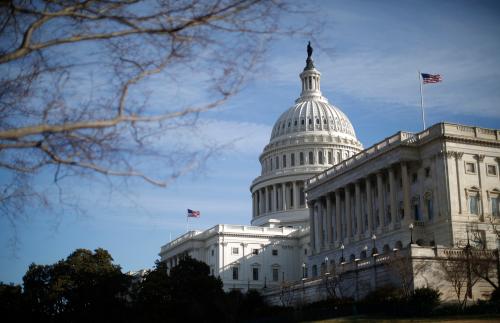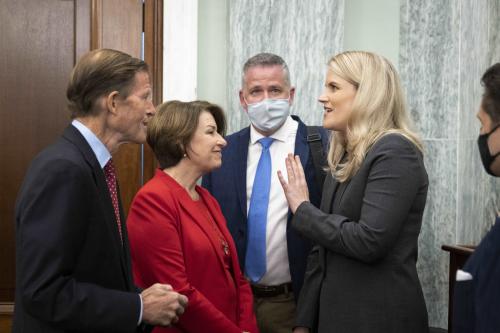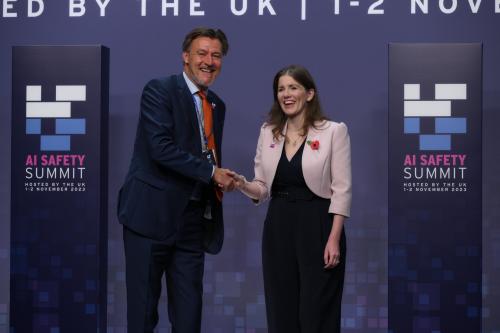The chaos surrounding Congress’s switch to remote work in response to the COVID-19 pandemic laid bare weaknesses of Congress’s technical procedures and infrastructure, from its inability to hold hearings by video or to conduct remote voting, to the absence of policies and appropriate technology to enable staff to work from home. As is often the case, necessity has proven to be the mother of invention—the COVID-19 pandemic required Congress to experiment with new technology and procedures, accelerating innovation, toppling past obstacles, and, ultimately, jump-starting modernization efforts.
Congress has long suffered from archaic technical infrastructure and processes. In January 2019, the House took a significant step towards identifying and addressing these issues with the establishment of a bipartisan Select Committee on the Modernization of Congress, with a mandate to “investigate, study, make findings, hold public hearings, and develop recommendations on modernizing Congress,” including on “technology and innovation.” The COVID-19 pandemic demonstrates why the work of the Select Committee is necessary and how much work remains in the efforts to modernize the House (and Senate).
In February 2019, the American Political Science Association created a Task Force Project on Congressional Reform to complement the work of the Select Committee and tasked the three of us with developing “technology and innovation” recommendations. Our analysis (completed before the pandemic) focused on the House of Representatives, highlighting examples of technical deficiencies within this chamber and noting that the root of many, if not most, of these shortcomings was cultural or organizational, not technical.
At a meta level, our report identified three fundamental “pacing problems,” that compromise Congress’ ability to legislate, conduct oversight, and operate effectively:
- The external pacing problem is Congress’s inability to understand and respond to technological evolution in society at large, resulting in policy and oversight that lags behind the pace of technical innovations.
- The inter-branch pacing problem captures the inability of Congress to keep pace with the executive branch as it employs technology for its own operations, making it hard for Congress to effectively exercise its oversight role and operate as a co-equal branch of government.
- The internal pacing problem refers to Congress’ near-complete incapacity to make effective use of technology for its internal operations and the day-to-day work of the institution.
In many ways, the COVID-19 pandemic has exposed the critical impact of these pacing problems. The internal pacing problem in particular meant that, at the start of the pandemic, Congress lacked the technological infrastructure in committee and member offices and for floor proceedings, threatening the continuity of congressional operations at a time when work needed to happen remotely. At the same time, the actions taken within Congress in response to COVID-19 have provided stark illustrations of the patterns and processes that contribute to the pacing problems—and some glimmers of hope that Congress is able to solve them.
Several recent events prompted by the pandemic illustrate these challenges and how Congress is adjusting and modernizing to address them.
Remote Work Options for Offices
The House was not prepared for remote work, but to the credit of the Committee on House Administration (CHA) and individual House offices, the institution adjusted quickly. On March 4, as it became apparent that some level of remote work would be required, the CHA Chair Zoe Lofgren (D, CA-19) and Ranking Member Rodney Davis (R, IL-13) informed members that unspent 2019 funds could be used to purchase technology needed for remote operations; that the Sergeant-At-Arms was offering guidance on continuity of operations planning; and that the Chief Administrative Officer would establish a House Telework Readiness Center.
Issues remain. Many staffers still do not have official devices and are, therefore, unable to access office systems remotely. Interns, who are an integral part of Capitol Hill work, cannot be issued official devices, leaving many unable to contribute substantively to their offices. However, the overall transition to remote work — going from almost none to nearly all congressional offices and committees working remotely within the span of a month — was remarkable.
Digital Submission
Many tasks on Capitol Hill have remained stubbornly paper-based over the years. Staffers (and interns) continue to perform tedious manual tasks such as walking bills and Dear Colleague letters around to collect signatures and entering bills or co-sponsorships physically on the House Floor. Some long-standing processes opened the institution to security vulnerabilities, such as the requirement that committee reports be submitted to the House Parliamentarian on thumb drives, providing an opportunity for malware to be introduced into House computers. Over the years, efforts to update these processes have confronted a status quo bias and a litany of arguments about why changes could not or should not happen.
These seemingly intractable objections were swiftly overcome on April 6, when Speaker Pelosi announced a new system for the digital submission of bills, co-sponsorships, and extension of remarks through an email system managed by the House Clerk, in partnership with the Parliamentarian. Within 48 hours, the system was operational, and by May 20, the digital submission of committee reports was also in place. As offices became familiar with the new system, it is now widely used.
Remote Proceedings and Process
One of the most significant illustrations of congressional actions regarding the evaluation, decision-making, and deployment of technology for its own operations has been the question of remote committee proceedings. Committees began experimenting with virtual or hybrid fora and roundtables. The first bipartisan convening was held by the House Committee on Veteran’s Affairs on April 28 and followed by the Senate Homeland Security and Government Affairs Permanent Subcommittee on Investigations on April 30. The Senate held the first official hybrid hearing on May 5 in Senate Banking, and the House changed its rules on May 15 to enable committees to hold virtual committee hearings and markups.
For those inside and outside Congress who have long advocated for more streamlined legislative processes supported by technology, the pace of these changes was significant, and in our view, an illustration that the barriers to a better functioning Congress are frequently not technical but rather a matter of culture, priority, and, crucially, organization. Congress has been slow to adopt new technologies because of institutional path dependence, a sense that the old ways are how things have always been done. In response to the COVID-19 crisis, the old ways were plainly no longer adequate and the House has adapted quickly and, importantly, worked collaboratively across different offices to prepare for remote work in the chamber. In these different instances, we see staff in different offices—who in the relatively siloed legislative branch are rarely in conversation with each other—coming together to evaluate technical solutions and issue recommendations for offices.
This experimentation follows the spirit of the modernization process for the House that we recommended in our APSA report on technology and innovation. We outlined a process that would bring together members and staff from a range of House offices to gather input from members, relevant stakeholders and experts and use data to assess technology options for the chamber as well as support voluntary pilot projects to systematically evaluate how new technologies would work in member and committee offices. The information collected in this process would capture the relative effectiveness of different tools and would inform best practice recommendations for the use of technology in the House. Offices and committees would still retain autonomy over their technology and office operations, but they would be able to rely on evidence-based information generated through this process about how tools would work in the congressional context when making their tech decisions.
This purposeful experimentation facilitates coordination and collaboration, similar to what we have seen play out as the Committee of House Administration supported the transition to remote work and the Clerk and Parliamentarian created the digital submission processes. But these examples represent ad hoc coordination in response to an immediate need—it is important that Congress support this kind of collaboration on an ongoing basis. To support sustained attention to technology modernization, we recommended in our 2019 APSA report the creation of a “House Technology Working Group” to facilitate continuous coordination around technology in the chamber. The working group would serve as a forum for collaboration, consultation with outside experts, the evaluation of pilot projects, and the dissemination of technology best practices. Of course, as a result of the recent rapid changes in how the House engages technology, our thinking about this recommendation is evolving.
Spurred to action out of necessity, Congress has taken significant strides by evaluating and adopting new technologies in the past few months. And the experience makes clear that Congress can benefit from consultation and collaboration around technology. The COVID-19 pandemic has jump-started technology modernization—the House Technology Working Group would build on that foundation and keep the momentum going.











Commentary
Congressional modernization jump-started by COVID-19
June 18, 2020